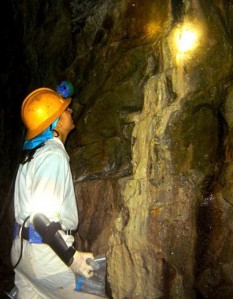
A bacterial biofilm growing on nutrient rich fracture water 1.3 km below the surface in Beatrix Gold Mine, South Africa. NOTE: This image does not represent the bacterial communities I sample.
In order to study life kilometers below the earth’s surface, subterraneauts travel underground through deep mine shafts around the globe. These scientists collect and analyze fracture waters that have been locked away for thousands of years — completely removed from the sun. The deepest and most well-studied mines are located in South Africa. Scientists that study these deep sites use a “prawn” or similar device (see below) attached to a borehole to sample water that hides meters beyond the mine’s walls.
One of the most recognized discoveries of deep subsurface research is the unprecedented identification of “an ecosystem of one”. Here, scientists performed a metagenomic study on a 2.8 km deep fracture water community and found that a novel bacterium, Candidatus Desulforudis audaxviator, accounted for >99.9% of the microbial community (Chivian et al., 2008). In order to survive on its own, the genome of D. audaxviator reveals Continue reading →
